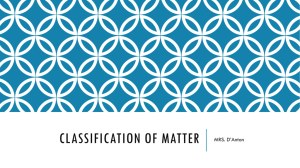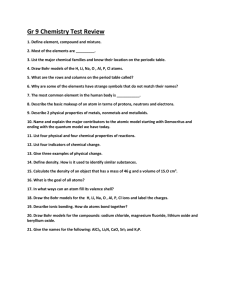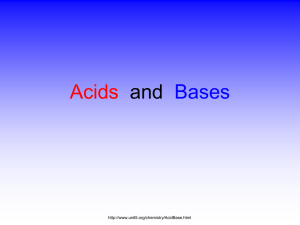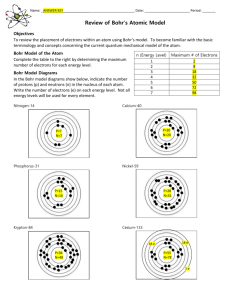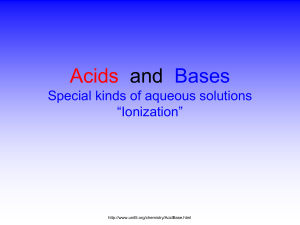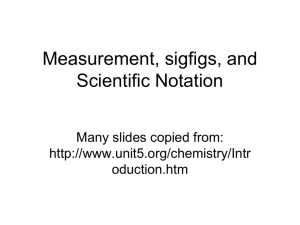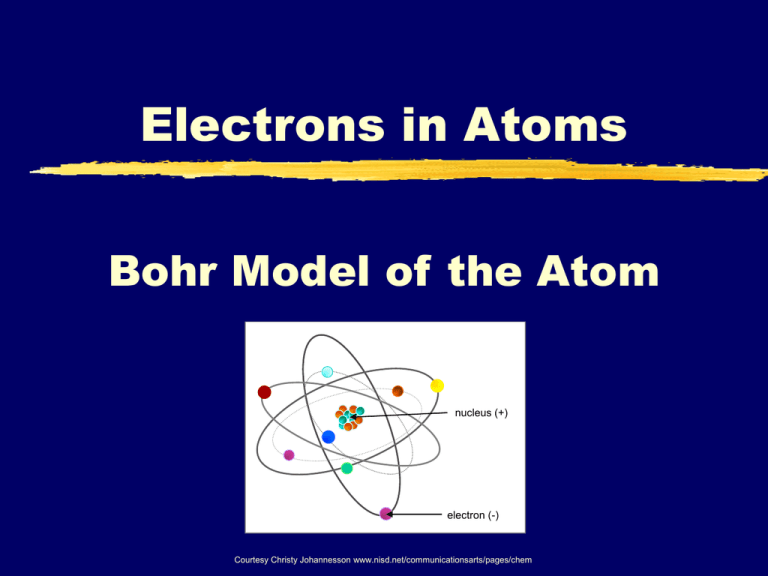
Electrons in Atoms
Bohr Model of the Atom
nucleus (+)
electron (-)
Courtesy Christy Johannesson www.nisd.net/communicationsarts/pages/chem
How color tells us about atoms
Atomic Spectrum
Prism
White light is made
up of all the colors of
the visible spectrum.
Passing it through a
prism separates it.
Author: Thomas V. Green Jr.
If the light is not white
By heating a gas or
with electricity we
can get it to give off
colors.
Passing this light
through a prism
does something
different.
Author: Thomas V. Green Jr.
Atomic Spectrum
Each element gives
off its own
characteristic colors.
Can be used to
identify the atom.
How we know what
stars are made of.
Author: Thomas V. Green Jr.
• These are called
line spectra
• unique to each
element.
• These are
emission spectra
• The light is
emitted given off.
Author: Thomas V. Green Jr.
Line-Emission Spectrum
excited state
Wavelength (nm)
410 nm
486 nm
434 nm
Slits
ENERGY IN
Prism
PHOTON OUT
ground state
Courtesy Christy Johannesson www.nisd.net/communicationsarts/pages/chem
656 nm
Bohr Model
• electrons exist only in orbits with specific
amounts of energy called energy levels
• Therefore…
• electrons can only gain or lose certain
amounts of energy
• only certain photons are produced
Courtesy Christy Johannesson www.nisd.net/communicationsarts/pages/chem
Bohr Model
6
5
4
3
2
1
nucleus
Energy of photon
depends on the
difference in energy
levels
Bohr’s calculated
energies matched the
IR, visible, and UV
lines for the H atom
Courtesy Christy Johannesson www.nisd.net/communicationsarts/pages/chem
Other Elements
Each element has a unique bright-line
emission spectrum.
i.e. “Atomic Fingerprint”
Helium
Bohr’s calculations only worked for
hydrogen!
Courtesy Christy Johannesson www.nisd.net/communicationsarts/pages/chem
Bohr’s Experiment
Kelter, Carr, Scott, Chemistry A Wolrd of Choices 1999, page 76
Animation by Raymond Chang – All rights reserved.
(a) Electronic absorption transition
(b) H2 emission spectrum (top), H2
absorption spectrum (bottom)
Copyright © 2007 Pearson Benjamin Cummings. All rights reserved.
continuous spectrum
gas
absorption spectrum
hot source
emission spectrum
Hydrogen Spectral Lines
Lyman series
(ultraviolet)
Frequency 1016
(hertz)
n=
765
4
Balmer series
(visible)
1015
3
2
1
Paschen series
(infrared)
1014
HYDROGEN SPECTRAL LINES
(ultraviolet)
(visible)
(infrared)
Copyright © 2007 Pearson Benjamin Cummings. All rights reserved.
Hydrogen Spectral Lines
Bohr’s model of the atom accounted mathematically for the energy of each of the transitions shown.
ionization
E6
E5
IR
region
656 nm
E4
E3
A
B
C
D
486 nm
Paschen (IR)
E2
Energy
A
B
C
D
E
434 nm
Balmer (Visible)
410 nm
UV
region
A
B
C
D
E
F
E1
Lyman series (UV)
Davis, Metcalfe, Williams, Castka, Modern Chemistry, 1999, page 97
Electronic Transitions in the
Excited Hydrogen Atom

